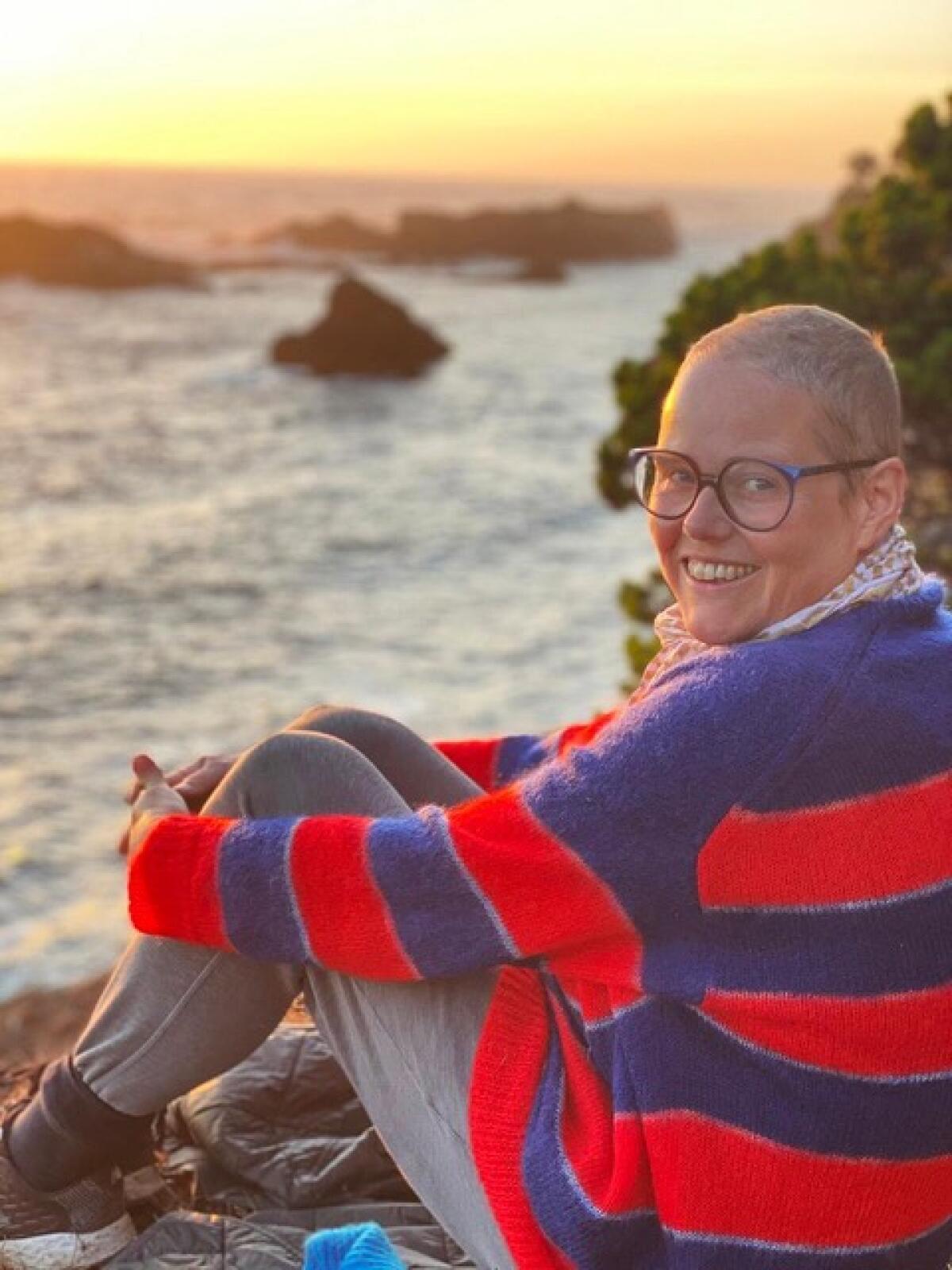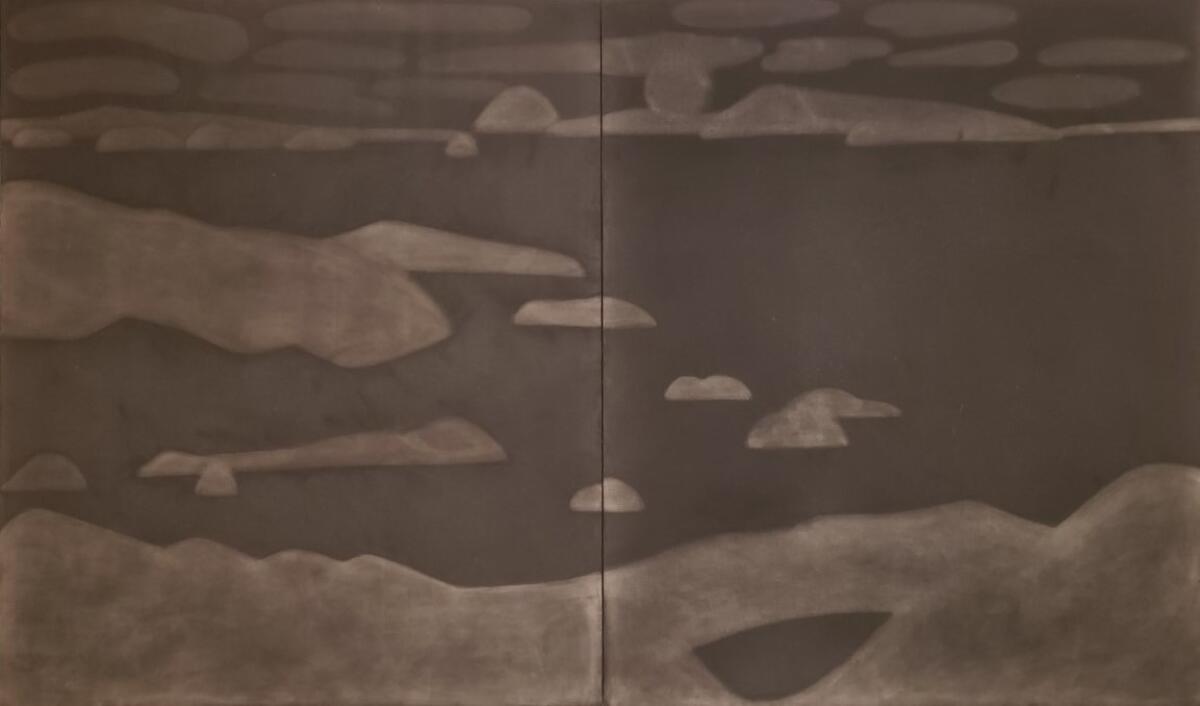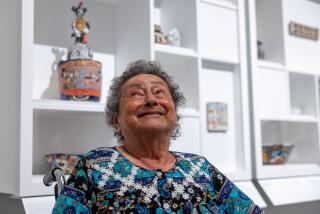Silke Otto-Knapp dies at 52: L.A. artist turned everyday movement into ephemeral painting

- Share via
Silke Otto-Knapp, an artist whose unusual technique of painting with layered watercolors on canvas to create large, enigmatic landscapes or figures in motion drew international attention over a career that spanned more than two decades, died Sunday morning at her home in Pasadena.
Two years ago, Otto-Knapp was diagnosed with ovarian cancer, which recently became aggressive. Her death was confirmed by Regen Projects, the Los Angeles gallery that represents her work. She was 52.
“In the waiting room (7),” a monumental three-panel painting of seven figures that stretch, kneel, dance, sprawl and otherwise physically exert themselves, was shown last year in a Regen Projects exhibition. As with much of her work, the painting was made by laying down delicate layers of watercolor, some of which Otto-Knapp then washed with a sponge or swept away with a dry brush.
Transparent paint soaked into the canvas weave, leaving visually elusive traces behind. Some was effectively erased, while the rest was pushed into adjacent areas where it built up. The ephemeral result is an image of shimmering, quicksilver figures in optically dense and visually absorbent spaces.

Poetic landscapes and seascapes formed another prominent body of work, sometimes evoking unsettled paintings by Norwegian Expressionist Edvard Munch, visionary landscapes by British Romantic artist Samuel Palmer or floating clouds by American artist Georgia O’Keeffe. For the 2016 “Made in L.A.” biennial exhibition at the UCLA Hammer Museum in Westwood, Otto-Knapp made a monumental six-panel painting for the entry stairwell. Beneath a shining moon, silvery gray islands and rocky fingers of land seem to drift within a vast, black, watery expanse.
Otto-Knapp’s figure paintings often refer to dance. She was especially attracted to those performance elements that reflected what she called “everyday movements,” such as simply reaching, bending or walking. The Ballets Russes, Polish dancer Bronislava Nijinska and American choreographer Yvonne Rainer are among the notable dance artists whose work informed her paintings.
In 2011 she participated in open rehearsals in the Turbine Hall of London’s Tate Modern, where British choreographer Michael Clark was preparing a public performance with 50 amateur dancers. The piece, “TH,” incorporated a contemplative pop music soundtrack by David Bowie, Pulp and Kraftwerk, as well as a monochrome stage design. The bodies of dancers she encountered there found their way into Otto-Knapp’s paintings.
The layering of watercolor to invoke movement or change also influenced her production of unique etchings. In some, three different plates were printed at different stages of production so that no single image would appear fixed or immutable.
It took 35 years, but the Orange County Museum of Art has a new home.
Born in Osnabrück, Germany, Otto-Knapp grew up on a dairy farm, which led to her deep interest in the natural world. She received a degree in cultural studies from the University of Hildesheim and a master of fine arts from the London school formerly called Chelsea College of Art and Design. Her first Los Angeles solo exhibitions were at Overduin and Kite Gallery in 2009 and 2013. She joined the faculty at UCLA as an associate professor of painting and drawing in 2015.
Otto-Knapp’s work has been exhibited internationally, including at galleries and museums in Berlin, Tokyo, Copenhagen, London, Vienna and Rome, as well as Los Angeles. Her work is in the collections of New York’s Museum of Modern Art, the Art Institute of Chicago, Tate Modern and others. Currently, a two-panel panting, “Monotone (Moonlit Scene after Samuel Palmer),” is included in “Joan Didion: What She Means,” a group exhibition featuring 63 artists and meant to evoke the late California writer’s ethos, opening this week at the Hammer Museum. A solo exhibition is scheduled to open later this month at Galerie Buchholz in New York.
Otto-Knapp is survived by sister Iris Madill; sister Kirsten Otto-Knapp and her husband, Holger; and nieces and nephews Jannik, Sophie and Matilda Otto-Knapp and Alfie Madill.
More to Read
The biggest entertainment stories
Get our big stories about Hollywood, film, television, music, arts, culture and more right in your inbox as soon as they publish.
You may occasionally receive promotional content from the Los Angeles Times.












